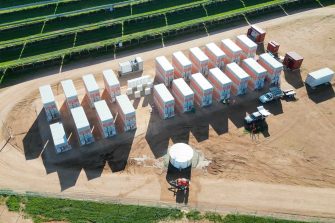Satellite technology for space and sea
Leading by example to build Australia’s space sector capability and beyond.

Share this story
Through the creation of new space resources and global navigation satellite system (GNSS) reflectometry approaches for space and airborne platforms, Professor Andrew Dempster and his team are improving the precision of satellite data in Australia to benefit a range of industries world-wide.
ACSER Team in 2017. Front row L-R Dr Joon Wayn Cheong, and Professor Andrew Dempster
As one of the country’s leading space experts and director of the Australian Centre for Space Engineering Research (ACSER) at UNSW, Professor Andrew Dempster’s research has been instrumental in the ongoing development of satellite systems and navigation for the last four decades.
Much of this influential work sits within the satellite data and signal processing space where Prof. Dempster and his team are working to improve the accuracy of GNSS receivers. These provide various services to a range of industries and users. “There are three big applications in this instance – agriculture, construction and mining,” says Prof. Dempster.
"Think about automated mining trucks that don’t fall off the side of the road because they know exactly where they are or driving your combine harvester up and down a field without any overlap."
- Professor Dempster
When flown on a platform such as a satellite, specialised receivers can also be used to monitor sea scapes to better help with accuracy of weather prediction. “When you’re trying to work out climate impacts, most of the measurements come from space,” explains Prof. Dempster. “The GPS signal reflects from the surface of the earth and we can then infer something about that reflection point – for example if it’s bouncing off the sea, you can tell how rough the sea is, the wind speed and the wind direction.” This data can then be used by weather prediction models to help forecast the future trajectory of cyclones.
This technology is also being used to monitor the ionosphere – a shell of electrons and electrically charged atoms and molecules surrounding the earth. Prof. Dempster and his team are building the hardware to accomplish this type of monitoring and help close the information gap.
“This region is not fully understood and is hard to measure, yet it’s the interface between our planet and space. It’s where much of the ultraviolet and x-ray radiation from the sun collides with the earth and generates auroras and potential hazards that can affect power grids, communications and GPS receivers.”
- Professor Dempster
The outcome of this research will be particularly significant for those within defence and government agencies whose interests are affected by ionospheric disturbance. “The more we know about the ionosphere’s behaviour, the better,” adds Prof. Dempster.
UNSW equipment is monitoring the thermosphere (part of the ionosphere) to understand how it impacts various industries and capabilities on earth.
Dr Joon Wayn Cheong adjusts the UNSW-ECO engineering model in the clean environment to enable "hardware in the loop" testing.
Dark side of the moon
Having set up the ACSER in 2010, Prof. Dempster’s work has also recognised the need for a local and dedicated space agency.
“The portfolio of what we do [in the centre] is quite fundamental to the way the Australian space sector has developed, and it’s changed the way the space industry works in Australia."
- Professor Dempster
Historically, Australia has played a discreet yet vital role in the space sector, having broadcast humanity’s first steps on the moon in 1969. UNSW’s foray into aerospace research began more than a decade before this with its first major international collaboration with NASA into shockwave analysis.
Space engineering however has come a long way since the moon-landing. For the last decade, Prof. Dempster and his team have also been focusing their attention on the development of space resources. “We’re currently looking at how you might go about getting water on the moon” he says. “We’re taking a unique approach because we’re bringing a mining engineering discipline to the space sector, which is quite different to the way everyone else does it.”
This work has led Prof. Dempster to other current projects including navigation on the moon. “We recently did a project with The University of Sydney and sponsored by the Space Research Network to look at what can you do with GPS navigation on the moon,” he explains. “Because you’re above the GPS satellites when you’re out there, you’ve got to look at the GPS satellites on the other side of the earth looking back at you.” In this instance, signals are very weak, and geometry is poor, so researchers need to be able to look carefully at all other available sensors.
While Australia’s work and impact within the space sector continues to expand, Prof. Dempster would love to see a stronger local space program emerge in the coming decades. This is something he believes is just on the horizon.
“10 years ago, no one thought Australia needed a space agency because it wasn’t necessarily something we had pursued or something we thought we could do here. But that has changed; we have become more independent, more free-thinking and more ambitious.”
- Professor Dempster
UNSW-ECO about to undergo thermal vacuum testing in the ANU's AITC Wombat facility.
Share this story
Read more
Get in touch and see what’s possible.
Ask how we can help your business, industry or market through collaboration.



